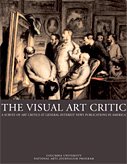
By Mary Lee Pappas
NUVO art critic
spring 2005
Should an art critic write about artists whose work they collect? Should an art critic fraternize with artists they write about? Should they accept gifts from artists they’ve written about, be an exhibition consultant, sit on boards of visual arts organizations, or exhibit their own artworks?
According to “The Visual Art Critic: A Survey of Art Critics at General-Interest News Publications in America” by Columbia University’s Journalism Program in 2002, there was no consensus among the 169 art critics surveyed (myself the only Indianapolis representative) regarding blanket ethical conduct within the American art world. This perhaps resulting from the public’s equally as uneven expectations of what art criticism ought and ought not to be.
An opinionated bunch to begin with, participating art critics had to have written at least twelve ”evaluative” pieces the previous year to qualify for the survey. Those are reviews that make judgments regarding quality, purport, and context based on the work, the artist, the venue, the curatorial competence, and sometimes funding. It’s gauging art instead of strictly spouting anthems of advocacy, subjective explanations, and taking strict emotions into account.
Critics, predominantly employed as part-timers or freelance at both daily and alternative weekly papers, were actually found to be “intimately connected” to their local arts communities. Is this conflict of interest, or fundamental for the role? 24% of us had worked in museums, 18% in commercial galleries, while nearly half of us were artists – 70% of whom exhibit or have exhibited their works. 14% were employed in art-related industries. Four out of five newspaper critics and three out of four alternative weekly critics collect art.
Though 90% of the critics were curiously Caucasian when multiculturalism in visual art is ever present, well preparedness for their work varied greatly. The majority of practicing art critics had on average 13 years of journalism/art writing experience. 20% of art critics had no formal training in art or art history, while only 26% of us actually had a B.A., M.A. or Ph.D. in art history. But, apparently it doesn’t really matter who’s writing about art anymore.
Some artists should, “Park their paints,” and let go of ego, pride and fickleness local painter, art historian, and gallery owner Doris Vlasek Hails said to me once. But there has been an increasing trend for artists and arts organizations across the country to steer clear of uncompromising critics and seek-out positive press thereby creating their own undeserving derivative art stars. Some buy it.
As our local visual arts community flourishes so too do the proliferating and, more often than not, only moderately talented artists who Indianapolis audiences so anxiously and sometimes bafflingly accept. Can anyone who can afford rent at a trendy studio be an artist? Are gallery owners and proprietors actually qualified to choose quality art to present to the public just because they can fund their venues? Who is drawing the line between hobby and excellence? Should critics simply relinquish themselves to this laissez-fare intellect regarding the fine art process and art history thereby giving artists and venues the praise they ultimately fancy? Where does criticism fit in and who really wants it anymore?
Indianapolis appears to be succeeding at placing novelty (or propaganda at times) above discrimination. The survey makes an example of our city by stating, “Citizens of significant urban agglomerations, including Indianapolis and Las Vegas…do not have the benefit of hearing from an art critic who might qualify for inclusion in this survey,” from a daily paper.
This perhaps in part because formal criticism doesn’t serve the city’s desires to make Indianapolis a cultural destination overnight. However, celebrating the mundane won’t make it happen either.
Though art critics across the board thought they were writing for a “lukewarm audience that is not too well steeped in the arts,” nearly two-thirds unfortunately write strictly positive reviews, with “rendering a personal judgement” about the artwork being “the least important factor in reviewing art.” It’s a sorry commentary that’s ultimately destructive of the arts evolution (like Indianapolis’ visual art growth spurt), and the art itself. So are gallery openings where the art plays second fiddle to the party.
Are arts writers accepting expenses on press junkets? Are papers merely supposed to conform, jump on the promotional bandwagon, and be another form of advertising?
Perhaps this is an indication that some “critics” should park their pens or thicken their skin. Perhaps local media should give more space and credence to the visual arts cultures of their communities, and artists should challenge themselves to create more than attractive formula paintings accompanied by contrived statements of purpose.
Local eagerness to be exceptional in the visual arts has created levels of administrative and artistic inferiority that can be remedied by demanding quality and education from those that serve the arts community, critics alike. Inferring that arts audiences and potential arts audiences are un or under educated (as is the rhetoric from artists and arts orgs.) only serves to insult and estrange audiences…as does substandard art.